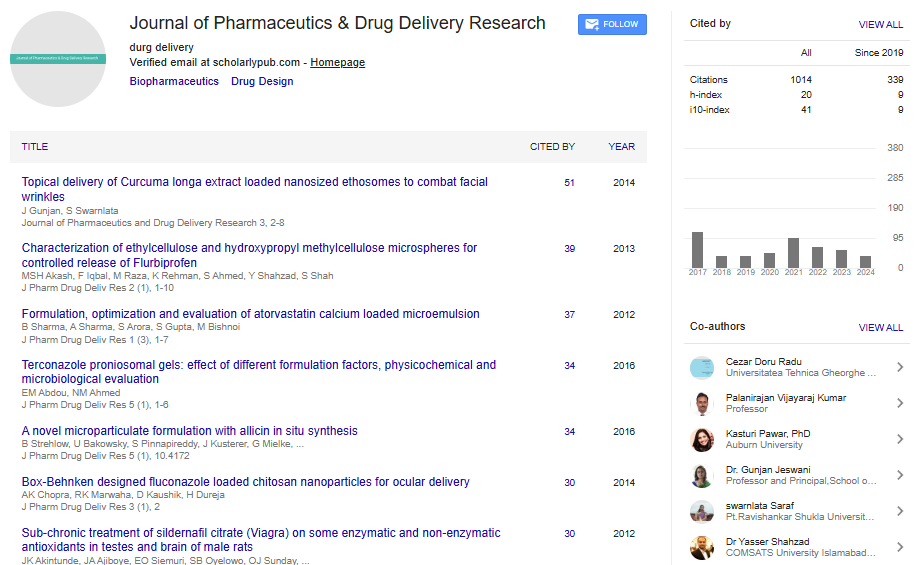Enhancement of Vaginal Penetration of Celecoxib Via Formulation of Chitosan - Coated Polymeric Nano capsules
Nermin E. Eleraky
Assiut University, Egypt
: J Pharm Drug Deliv Res
Abstract
Vaginal administration of drugs suffers from many limitations, e.g., the short contact time or continuous carrier wash-out. Thus, the development of new carriers for gynecological use is necessary. Celecoxib, a selective cyclo-oxygenase-2 inhibitor, is a poorly water-soluble drug with oral bioavailability of around 40%. Besides, long-term oral administration of celecoxib produces gastrointestinal side effects. The hypothesis of the present work was to augment the permeation of celecoxib through the vaginal mucosa via its incorporation within chitosan-coated polymeric Nano capsules formulation. The chitosan-coated polymeric Nano capsules were prepared by the nanoprecipitation method followed by ultra-sonication. The developed Nano capsules were characterized in terms of Nano capsules size, surface charge, encapsulation efficiency %, and mucoadhesive force. In vitro drug release and drug permeability across rabbit vaginal mucosa were also assessed. The optimized formulation comprised of celecoxib (20 mg), oleic acid (500 mg), lecithin (20 mg), Tween®40 (30 mg), cetyl trimethyl ammonium bromide (CTAB) (7.5 mg) and chitosan (0.3% w/v) displayed a particle size of 574.9 ± 13.06 nm, zeta potential of +34.56 ± 3.65 mV, encapsulation efficiency of 88.54 ± 0.18%, and mucoadhesive force of 2.6 ± 0.56 Pas. In vitro release studies displayed a sustained release pattern of celecoxib from chitosancoated polymeric Nano capsules compared to the free drug dispersion. An in vitro vaginal permeation study showed better permeation-enhancing ability of the developed celecoxib laden chitosan-coated polymeric Nano capsules (~ 4 folds) compared to that of free drug dispersion. The developed chitosan-coated polymeric Nano capsules might provide a promising carrier for vaginal drug delivery for control of inflammation.
Biography
Nermin E. Eleraky has completed her PhD at the age of 33 years as a fellowship from James L. Winkle college of Pharmacy, Cincinnati University and postdoctoral studies from Assiut University School of Pharmacy. She is a lecturer in Faculty of Pharmacy, Assiut University, Egypt. She has published 12 papers in reputed journals and has been serving as a reviewer in respective journals.
 Spanish
Spanish  Chinese
Chinese  Russian
Russian  German
German  French
French  Japanese
Japanese  Portuguese
Portuguese  Hindi
Hindi 
